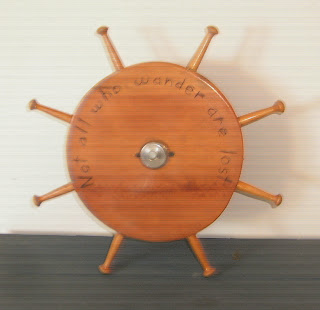Everyone gets those days that everything seams to go down hill. My Tuesday day started bad and then, mid morning it got much worse.
The first thing I did was spill my coffee on myself before I
had even had a sip of it. I figured it would get better after I had my coffee.
There had been a down pour of rain last night so I figured I should check the
boats first thing.
I got quickly side tracked to scoop the cat litter box. Our
newest cat that we inherited from my sister would not use it till it was
scooped. The cat yowled outside of the box till the butler service was done. He is training me to meet his needs!
I got down to the boats and found the tender needed bailing
and all three boats needed hosing off. The trees riverside look so beautiful,
but they are messy when it rains. The boats were covered with leaves and seeds
from the trees. I used the leaf blower to get the big stuff off then hosed and
boat brushed the rest off. I got well grunged,
but the dog loved it.
I took my soggy self up to the house for a shower. I thought I would use the shower off our
bedroom. We do not use that shower much because that bathroom is not laid out
well. The shower is too small and it is hard to get into because the toilet is
in the way. The shower must have been an afterthought when the bathroom was
laid out. The shower is actually a projection into the garage and tucked into
a small space by the water heater. They should have relocated the water heater
and put the shower where it was.
The unused shower had a few cleaning things in it in a
bucket, so I figured I would give the shower stall a cleaning at the same time
as I cleaned myself. I emptied out the shower, got undressed and tried to turn
on the shower. The knob would not move. I muscled it and it moved a little. I
tried to think when the shower was last used and put more force on the knob. The
water came and the knob broke off. The water was ice cold and the stall was too
small to get out of the way of the cold stream of water. I spoke French and I
saw two cats and the dog run out of the bedroom.
The broken knob would not work to turn off the water. There
is no turn off valves for the shower water source. Wet muddy, grungy me had to get out of the
stall, dry off a little, throw something on and go outside, across the back yard
to the pump shed and unplug the water system pump. I flipped the hot water
heater breaker off and went to my plumbing stuff to see if I had a spare knob
or something I could use to turn off the water.
I gathered some tools and headed back to the shower. The
telephone rang. A woman speaking broken English wanted me to take a few minutes
to go through a survey on…I hung up on her. The dog looked at me from across
the room and just the tip of his tail was flipping slowly. He did not
move.
I got the shower turned off, then had to go back out side
and turn the water back on and rushed quickly back in to see if it was truly
off. I was feeling good that at least
that worked.
I went to the other bathroom, got undressed again and hopped
under the shower. The water was not all that hot, and I figured it would warm
up as I showered. I got most of the way clean and the water turned COLD. Most
of the hot water had emptied of the hot water heater at the other shower stall
and when I turned on the water, I did not turn on the power to the water
heater. I quickly finished up speaking more French. I dried off and found I had trashed both
bathrooms and tracked stuff all through the house. Hey, It could have been
worse…ceramic tile is easier to clean up then carpet would have been.
About an hour later I had most everything cleaned up, and
even the shower stall was clean. The dog was acting normal, and all I needed to
do was get a replacement knob.
The dog and I went to the hardware store for a replacement
knob. I found that a replacement knob cost more than a cheap replacement
fixture of the same brand. So I bought the replacement fixture to get the knob.
I can, maybe down the road, replace the stiff fixture with the one I bought if
needed.
I sure hope my wife asks me how my day was, so I can tell
her this story. 8-)
PS: She did not ask how my day was, so I ask her if she would read this blog. I got a "Poor Baby" after she read it. *-)






